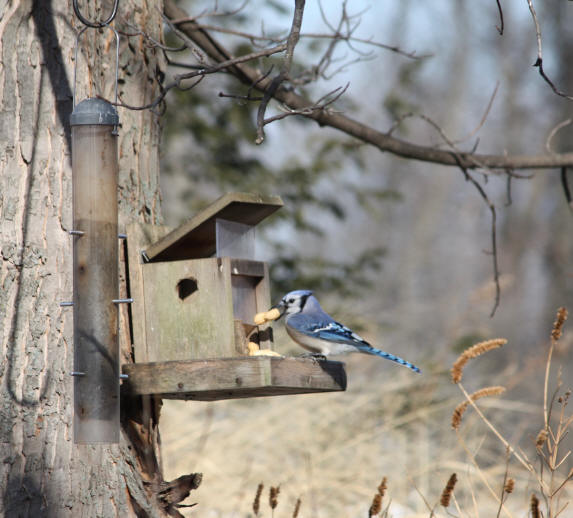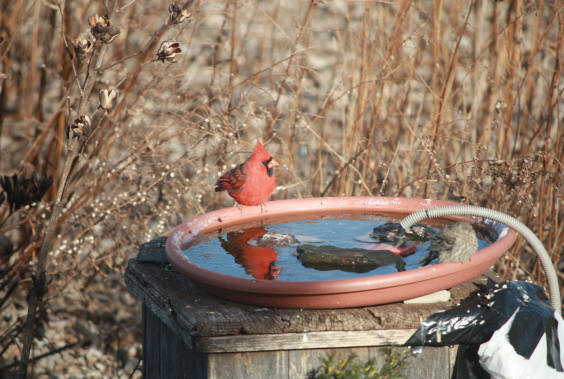|
Bird Feeding – A Winter Activity
Mary Ann Ryan
Adams County Master Gardener
 Over the Thanksgiving holiday, my family visited my husband's brother and his family in Fort Drum, NY. The neighborhood was straight out of the 50's – all the
homes looked the same on the same size lot, the same distance apart. There were little to no plants or trees as the neighborhood was just completed. It snowed about 5 inches on Saturday and an additional dusting on Sunday. When venturing out on Saturday morning, kids were
out building snowmen and shoveling snow. I saw a couple of kids pulling sleds, although I have no idea where they were headed. June Cleaver was probably inside baking cookies waiting for Beaver to come home after a busy day in the snow. Over the Thanksgiving holiday, my family visited my husband's brother and his family in Fort Drum, NY. The neighborhood was straight out of the 50's – all the
homes looked the same on the same size lot, the same distance apart. There were little to no plants or trees as the neighborhood was just completed. It snowed about 5 inches on Saturday and an additional dusting on Sunday. When venturing out on Saturday morning, kids were
out building snowmen and shoveling snow. I saw a couple of kids pulling sleds, although I have no idea where they were headed. June Cleaver was probably inside baking cookies waiting for Beaver to come home after a busy day in the snow.
But bird life? There was none to be seen. No plants with seed heads to attract the playful feathered friends, no feeders on posts or attached to trees to bring the birds to the neighborhood, no evergreens to give shelter - a sad outcome of
any new neighborhood that's been started from scratch. The neighborhood was alive with people, but dead of wildlife – a scenario that can certainly be fixed.
Watching birds in the winter is enjoyable and fun to do. During the dreary days, we can lift our spirits by watching the little creatures flitting around the feeders and seed heads of perennials, and in and out of evergreen trees and shrubs.
Our feeders are outside our kitchen window, and I can watch the activity for quite a long time as the birds visit different feeders. It makes washing dishes an enjoyable task!
Many types of birds visit in any given period of time. Woodpeckers (red-bellied and downy), chickadees, juncos, white-throated sparrows, house finches, cardinals and tufted titmice grace us with their presence. An assortment of feeders and
feed will attract a larger variety of our flying friends.
Plant Life: When planning for winter visitors, plant things that have seed heads that can remain through the winter months. Common perennials such as black-eyed susans, coneflowers, and asters will provide seeds. Evergreen shrubs and trees,
like inkberry holly, American holly and white pines will provide shelter for the birds. Deciduous shrubs like viburnums, winterberry holly and sumac provide berries.
Supplemental Food: We can supplement this natural food source by providing additional seed through bird feeders. Many styles of feeders are available, from tubes and platforms to nets and hoppers. The more variety of feeders you provide, the
more variety of visitors you will have. Tube feeders typically attract finches, while the platform feeders will attract larger birds like cardinals and blue jays and the netting can be filled with suet for the woodpeckers.

Just as there are a variety of feeders, so goes the types of feed. Millet, sunflowers, corn and peanut butter can all be a food source for birds. The most versatile seed is the black oil sunflower seed. This seed can be mixed with peanut
butter and put into suet feeders to attract woodpeckers; it can be used in hoppers as well as platform feeders for the cardinals, chickadees and titmice. The least useful is millet. Typically when buying a bird feed mix, the millet is what the birds will scratch to the
ground and discard. It's mostly just a filler to add weight for the bag. Niger (thistle seed) is used in the tube feeders for the finches. These are tiny seeds and are typically on the pricier side, but the birds just love it! A Christmas tradition in our family is to smear
peanut butter onto pinecones and hang them on the trees. We also use orange and apple slices, string them together for ornaments and have an outdoor Christmas tree for the birds! Even at 17, my oldest daughter still enjoys this holiday tradition.
Water: For best bird activity and bird health, not only should you provide a food source and shelter, but you should also provide water. A heated birdbath can provide that. There are many types of bird baths and heaters on the market. Small
fish ponds, or just a clean dish of shallow water set out each morning can provide this source of water as well.

Enjoy the quiet of the winter and the flurry of bird activity. Enjoy the relaxation now, because spring is just around the corner!
Read other winter related gardening articles
Read other articles on birds, wildlife & beneficial insects
Read other articles by Mary Ann Ryan |